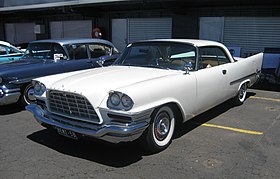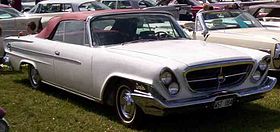Chrysler 300L
| Chrysler 300 | |
|---|---|

1964 Chrysler 300-K Convertible
|
|
| Overview | |
| Manufacturer | Chrysler (Chrysler Corporation) |
| Production |
|
| Assembly | Los Angeles (Maywood) Assembly |
| Layout | FR layout |
| Chronology | |
| Predecessor | Chrysler Windsor |
| Successor | Chrysler 300 non-letter series |
| C-300 | |
|---|---|

1955 Chrysler C-300
|
|
| Overview | |
| Production |
|
| Body and chassis | |
| Body style | 2-door hardtop |
| Powertrain | |
| Engine | 331 cu in (5.4 L) FirePower V8 |
| Transmission | 2-speed PowerFlite automatic |
| Dimensions | |
| Wheelbase | 126 in (3,200 mm) |
| Length | 218.8 in (5,558 mm) |
| Width | 79.1 in (2,009 mm) |
| 300B | |
|---|---|
 |
|
| Overview | |
| Production |
|
| Body and chassis | |
| Body style | 2-door hardtop |
| Related |
DeSoto Adventurer DeSoto Fireflite |
| Powertrain | |
| Engine | |
| Transmission |
|
| Dimensions | |
| Wheelbase | 126 in (3,200 mm) |
| Length | 218.8 in (5,558 mm) |
| Width | 79.1 in (2,009 mm) |
| 300C | |
|---|---|
 |
|
| Overview | |
| Production |
|
| Body and chassis | |
| Body style |
|
| Related | DeSoto Adventurer |
| Powertrain | |
| Engine | 392 cu in (6.4 L) FirePower V8 |
| Transmission | 3-speed TorqueFlite A488 automatic |
| Dimensions | |
| Wheelbase | 126.0 in (3,200 mm) |
| Length | 219.2 in (5,568 mm) |
| Width | 78.8 in (2,002 mm) |
| 300D | |
|---|---|
 |
|
| Overview | |
| Production |
|
| Body and chassis | |
| Body style |
|
| Related | DeSoto Adventurer |
| Powertrain | |
| Engine | 392 cu in (6.4 L) FirePower V8 |
| Dimensions | |
| Wheelbase | 126.0 in (3,200 mm) |
| Length | 220 in (5,588 mm) |
| Width | 78.8 in (2,002 mm) |
| 300E | |
|---|---|
 |
|
| Overview | |
| Production |
|
| Body and chassis | |
| Body style |
|
| Related | DeSoto Adventurer |
| Powertrain | |
| Engine | 413 cu in (6.8 L) Golden Lion V8 |
| Dimensions | |
| Wheelbase | 126 in (3,200 mm) |
| Length | 220.9 in (5,611 mm) |
| 300F | |
|---|---|

1960 Chrysler 300F Hardtop
|
|
| Overview | |
| Production |
|
| Body and chassis | |
| Body style |
|
| Related | DeSoto Adventurer |
| Powertrain | |
| Engine | 413 cu in (6.8 L) RB V8 |
| Transmission |
|
| Dimensions | |
| Wheelbase | 126 in (3,200 mm) |
| Length | 219.6 in (5,578 mm)" |
| 300G | |
|---|---|

1961 Chrysler 300-G
|
|
| Overview | |
| Production | 1961 |
| Body and chassis | |
| Body style |
|
| Powertrain | |
| Engine | 413 cu in (6.8 L) RB V8 |
| Transmission | |
| Dimensions | |
| Wheelbase | 126 in (3,200 mm) |
| Length | 219.8 in (5,583 mm) |
| 300H | |
|---|---|
 |
|
| Overview | |
| Production |
|
| Body and chassis | |
| Body style |
|
| Powertrain | |
| Engine | 413 cu in (6.8 L) RB V8 |
| Transmission | 3-speed automatic |
| Dimensions | |
| Wheelbase | 122 in (3,099 mm) |
| 300J | |
|---|---|
| Overview | |
| Production |
|
| Body and chassis | |
| Body style | 2-door coupe |
| Powertrain | |
| Engine | 413 cu in (6.8 L) RB V8 |
| Transmission | 3-speed automatic |
| Dimensions | |
| Wheelbase | 122 in (3,099 mm) |
The Chrysler 300 "letter series" are high-performance personal luxury cars that were built by Chrysler in the U.S. from 1955 to 1965. After the initial year, which was named 300-C, the 1956 cars were designated 300B. Successive model years were given the next letter of the alphabet as a suffix (skipping "i"), reaching the 300L by 1965, after which the model was dropped.
The 300 "letter series" cars were among the vehicles that focused on performance built by domestic U.S. manufacturers after World War II, and thus can be considered one of the muscle car's ancestors, though full-sized and more expensive.
The automaker began using the 300 designations again for performance-luxury sedans, using the 300M nameplate from 1999 to 2004, and expanding the 300 series with a new V8-powered 300C, the top model of a new Chrysler 300 line, a new rear-wheel drive car launched in 2004 for the 2005 model year. Unlike the first "letter series" series, the successive variants do not feature standard engines producing at least 300 hp (220 kW), except for Chrysler's current top-line 300C models.
This first of the letter series cars did not bear a letter, but can retroactively be considered the '300A'. The 'C-' designation was applied to all Chrysler models; however for marketing purposes the numerical series skipped more than 225 numbers forward in sequence in order to further reinforce the 300's bhp rating. The 300 originally stood for the 300 hp (220 kW) engine. The C-300 was really a racecar aimed at the NASCAR circuits that was sold for the road for homologation purposes, with Chrysler's most powerful engine, the 331 cu in (5.4 L) FirePower "Hemi" V8, due to the hemispheric shape of the combustion chambers, fitted with twin 4-barrel carburetors, a race-profiled camshaft setup, solid valve lifters, stiffer suspension, and a performance exhaust system. By 1956 this would be the first American production car to top 355 hp (265 kW), and the letter series was for many years the most powerful car produced in the United States.
...
Wikipedia
